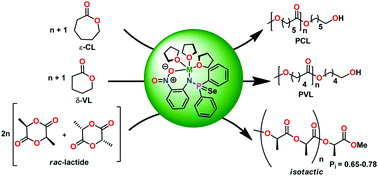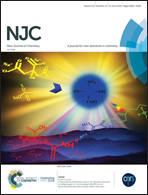Alkali metal complex-mediated ring-opening polymerization of rac-LA, ε-caprolactone, and δ-valerolactone†
Abstract
A series of alkali metal complexes formed by N-(2-fluoro/2-nitro phenyl)-P,P-diphenylphosphinoselenoic amide [(Ph2P(Se)NH(2-RC6H4))] [R = F (1-H); NO2 (2-H)] ligands with molecular formulas [M(THF)2(Ph2P(Se)N(2-RC6H4))] [M = Li, R = F (3a), NO2 (3b)] and [M(THF)2(Ph2P(Se)N(2-RC6H4))] [M = Na, R = F (4a), NO2 (4b); M = K, R = F (5a), NO2 (5b)] have been synthesized in great yield and fully characterized. The molecular structures of protic-ligands 1-H and 2-H, and alkali metal complexes 3b, 4a, and 4b were analyzed using single-crystal X-ray diffraction analysis. Sodium and potassium complexes 4a,b and 5a,b were proved to be active catalysts for the ring-opening polymerization (ROP) of rac-LA (rac-LA), ε-caprolactone, and δ-valerolactone at room temperature only. The best isoselectivity of poly(lactide) (PLA) was achieved to a high value of Pi = 0.78 using sodium complex 4b. One exceedingly dynamic potassium complex (5a, 5b) even can catalyze the polymerization of 1000 counterparts of rac-LA and yield polylactide with a high molecular weight and narrow polydispersity record (PDI). Experimental outcomes also showed steric hindrance, and electronic impacts have noteworthy consequences for this catalysis in the ROP of rac-LA.



 Please wait while we load your content...
Please wait while we load your content...